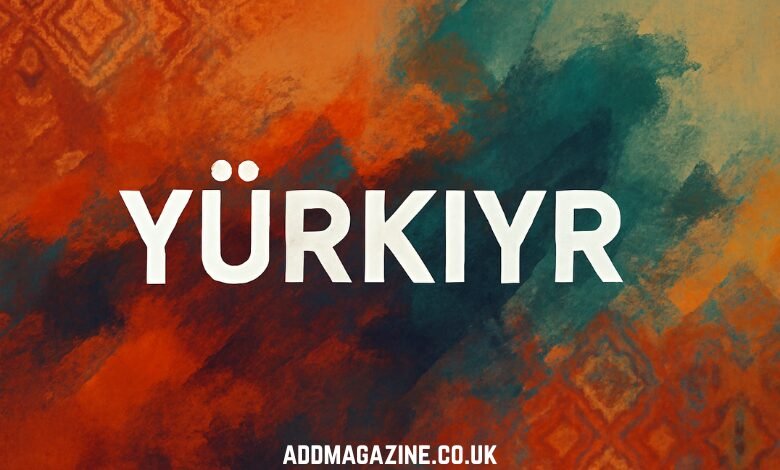The term “Yürkiyr” is more than just a word; it is a cultural concept that invites exploration and interpretation. While its exact definition may seem elusive, its significance lies in its connection to the broader themes of movement, transformation, and cultural resilience. Rooted in Turkish linguistic traditions, the word invokes the notion of “walking” or “moving forward,” but its deeper meanings stretch beyond simple physical motion. As Yürkiyr becomes more prominent, especially in creative and artistic circles, it serves as both a reflection of cultural heritage and a beacon for innovation in art and personal growth.
The Linguistic and Cultural Roots of Yürkiyr
At its core, “Yürkiyr” stems from the Turkish root “yür-,” which denotes walking or movement. This root carries with it an intrinsic connection to progress—a forward momentum that is not just about physical motion, but also about intellectual and emotional growth. As societies evolve, the concept of movement often symbolizes change, both internal and external. Yürkiyr reflects this ethos, symbolizing not just an individual’s journey, but the collective movement of culture through time.
In Turkish folklore and culture, the idea of walking or traveling holds significant importance. Historically, the nomadic Yörük people of Anatolia traveled vast distances, carrying their traditions with them. This journey wasn’t just about moving from one place to another; it was about carrying stories, arts, and customs, while constantly adapting to the new environments they encountered. This nomadic legacy resonates within the Yürkiyr concept, which mirrors both the tangible act of movement and the more abstract notion of cultural evolution.
Yürkiyr in Modern Culture
While Yürkiyr has deep historical and cultural ties, it has found new life in contemporary conversations about art, culture, and identity. Today, it represents more than just a relic of the past; it is a symbol of resilience and reinvention in modern society. As digital platforms and global connectivity continue to reshape our world, Yürkiyr has emerged as a cultural touchstone for communities seeking to merge the old with the new, blending traditional practices with cutting-edge technology.
In modern Turkish society, people are looking for new ways to interpret and embrace their heritage. The idea of Yürkiyr speaks to this desire for cultural continuity, while also acknowledging the need for reinvention and growth. It represents a space where tradition and innovation can coexist, where the stories of the past can be retold with a contemporary twist.
The Hybrid Philosophy of Yürkiyr
Yürkiyr is not confined to a single tradition or aesthetic; it is a hybrid philosophy that honors both the past and the future. The word itself evokes a sense of movement, suggesting that culture is not static but always in flux. The notion of combining the old with the new is essential to understanding Yürkiyr. Just as the Yörük people carried their heritage with them on their journeys, so too does the concept of Yürkiyr carry with it the potential for transformation.
The fusion of modern innovation with ancestral practices is a defining characteristic of the Yürkiyr movement. As it gains traction in various creative fields, the concept is embraced by artists, designers, and cultural leaders who are eager to create something that transcends traditional boundaries. Yürkiyr offers a lens through which they can look at the world—a way to bridge the gap between age-old customs and contemporary expressions.
The Role of Yürkiyr in Art and Design
One of the most significant ways Yürkiyr has manifested in contemporary culture is through the arts. In visual arts, for example, artists are using the Yürkiyr concept to blend traditional folklore patterns with digital technologies. This intersection of the old and the new results in artworks that speak to the dynamic nature of culture. These works do not simply aim to preserve the past; they reinterpret it, adding layers of complexity and innovation to age-old designs.
For designers, Yürkiyr represents an opportunity to create immersive and interactive experiences that invite participation rather than passive viewing. Sensory design—combining visual, auditory, and tactile elements—is a growing trend in which the Yürkiyr philosophy plays a vital role. By integrating elements of Turkish culture, such as textile patterns, folk symbols, and rituals, designers are crafting spaces that tell stories while encouraging audience engagement. This approach not only invites viewers to become part of the experience but also encourages a deeper understanding of the cultural roots that inform the design.
The Yürkiyr aesthetic is not confined to any single form or medium; rather, it is a mindset that allows for the integration of various artistic elements. The idea is to create work that acknowledges the complexities of identity—both personal and collective—and that reflects the ongoing evolution of culture.
Yürkiyr and Personal Growth
In addition to its cultural significance, Yürkiyr has come to symbolize personal growth and transformation. Just as the root word “yür-” implies forward motion, so too does the concept of Yürkiyr encourage individuals to progress in their own lives. It serves as a reminder that growth is an ongoing journey, not a fixed destination.
For many, the journey of Yürkiyr is not just about cultural preservation or artistic innovation; it is also a path of self-discovery. The act of moving forward—whether through artistic creation, cultural exploration, or personal development—is central to the Yürkiyr philosophy. As people engage with this idea, they are reminded that change is not something to fear but to embrace, as it opens the door to new opportunities for growth.
Yürkiyr and Global Creativity
As Yürkiyr continues to evolve, it is increasingly finding resonance in the global creative community. In a world that is more interconnected than ever before, the blending of diverse cultural influences has become a hallmark of contemporary art. Yürkiyr, with its rich cultural roots and forward-looking ethos, provides a framework for exploring the intersections of tradition, technology, and global creativity.
Artists and designers from around the world are embracing the Yürkiyr concept, not just as a Turkish cultural symbol, but as a universal idea that transcends borders. This is evident in the growing number of collaborative projects, digital art installations, and cross-cultural exchanges that draw inspiration from the Yürkiyr movement. Through these efforts, Yürkiyr is helping to redefine what it means to create in a globalized world—where the past and the future can coexist in dynamic and innovative ways.
Conclusion
The concept of Yürkiyr is a multifaceted and evolving idea that speaks to movement, transformation, and cultural resilience. Rooted in Turkish tradition but with universal appeal, it offers a framework for understanding the ways in which culture and identity evolve over time. Whether through art, design, or personal growth, Yürkiyr invites us to reflect on the journey of progress—both individual and collective.
As the Yürkiyr movement continues to grow, it will undoubtedly inspire more people to explore the rich intersection of heritage and innovation. It serves as a reminder that cultural resilience is not about preserving the past in a static form, but about adapting and evolving in ways that honor tradition while embracing the possibilities of the future. Whether in the digital realm, in artistic expression, or in personal development, Yürkiyr represents a journey of continuous motion—one that invites all of us to walk forward, together.
FAQs
1. What does “Yürkiyr” mean?
Yürkiyr is derived from the Turkish word for movement or walking, symbolizing progress, transformation, and cultural continuity.
2. How is Yürkiyr linked to Turkish culture?
It draws from traditions of nomadic cultures like the Yörük people and merges these with modern, global creative expressions.
3. What role does Yürkiyr play in art?
Yürkiyr inspires artists to combine folklore with digital art, creating immersive experiences that reflect cultural evolution and innovation.
4. Is Yürkiyr only relevant to Turkish culture?
While rooted in Turkish traditions, Yürkiyr’s themes of movement and transformation resonate globally, transcending cultural and geographical boundaries.
5. How can I experience Yürkiyr?
You can engage with Yürkiyr through art installations, digital experiences, and creative projects that fuse the traditional with the modern.




